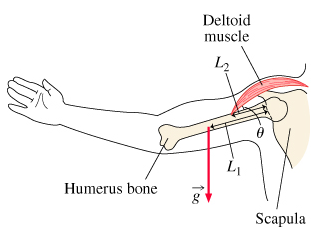You are able to hold out your arm in an outstretched horizontal position because of the action of the deltoid muscle. Assume the humerus bone has a mass M₁ = 3.6 kg, length L=0.66 m and its center of mass is a distance L₁ = 0.33 m from the scapula. (For his problem ignore the rest of the arm.) The deltoid muscle attaches to the humerus a distance L₂ = 0.15 m from the scapula. The deltoid muscle makes an angle of 0 = 17° with the horizontal, as shown. (Figure 1) (Figure 2)Use g = 9.8 m/s² throughout the problem.
You are able to hold out your arm in an outstretched horizontal position because of the action of the deltoid muscle. Assume the humerus bone has a mass M₁ = 3.6 kg, length L=0.66 m and its center of mass is a distance L₁ = 0.33 m from the scapula. (For his problem ignore the rest of the arm.) The deltoid muscle attaches to the humerus a distance L₂ = 0.15 m from the scapula. The deltoid muscle makes an angle of 0 = 17° with the horizontal, as shown. (Figure 1) (Figure 2)Use g = 9.8 m/s² throughout the problem.
Physics for Scientists and Engineers: Foundations and Connections
1st Edition
ISBN:9781133939146
Author:Katz, Debora M.
Publisher:Katz, Debora M.
Chapter14: Static Equilibrium, Elasticity, And Fracture
Section: Chapter Questions
Problem 31PQ: A wooden door 2.1 m high and 0.90 m wide is hung by two hinges 1.8 m apart. The lower hinge is 15 cm...
Related questions
Question
100%
- Find the tension T in the deltoid muscle.
- Using the conditions for static equilibrium, find the magnitude of the vertical component of the force Fy exerted by the scapula on the humerus (where the humerus attaches to the rest of the body).
- Now find the magnitude of the horizontal component of the force Fx exerted by the scapula on the humerus.

Transcribed Image Text:You are able to hold out your arm in an outstretched horizontal position because of the
action of the deltoid muscle. Assume the humerus bone has a mass M₁ = 3.6 kg, length
L = 0.66 m and its center of mass is a distance L₁ = 0.33 m from the scapula. (For
this problem ignore the rest of the arm.) The deltoid muscle attaches to the humerus a
distance L₂ = 0.15 m from the scapula. The deltoid muscle makes an angle of 0 = 17°
with the horizontal, as shown. (Figure 1) (Figure 2)Use g = 9.8 m/s² throughout the
problem.

Transcribed Image Text:Humerus bone
Deltoid
muscle
4₂2
100
4₁
Scapula
Expert Solution
This question has been solved!
Explore an expertly crafted, step-by-step solution for a thorough understanding of key concepts.
This is a popular solution!
Trending now
This is a popular solution!
Step by step
Solved in 2 steps with 2 images

Knowledge Booster
Learn more about
Need a deep-dive on the concept behind this application? Look no further. Learn more about this topic, physics and related others by exploring similar questions and additional content below.Recommended textbooks for you

Physics for Scientists and Engineers: Foundations…
Physics
ISBN:
9781133939146
Author:
Katz, Debora M.
Publisher:
Cengage Learning

Principles of Physics: A Calculus-Based Text
Physics
ISBN:
9781133104261
Author:
Raymond A. Serway, John W. Jewett
Publisher:
Cengage Learning

Glencoe Physics: Principles and Problems, Student…
Physics
ISBN:
9780078807213
Author:
Paul W. Zitzewitz
Publisher:
Glencoe/McGraw-Hill

Physics for Scientists and Engineers: Foundations…
Physics
ISBN:
9781133939146
Author:
Katz, Debora M.
Publisher:
Cengage Learning

Principles of Physics: A Calculus-Based Text
Physics
ISBN:
9781133104261
Author:
Raymond A. Serway, John W. Jewett
Publisher:
Cengage Learning

Glencoe Physics: Principles and Problems, Student…
Physics
ISBN:
9780078807213
Author:
Paul W. Zitzewitz
Publisher:
Glencoe/McGraw-Hill

Physics for Scientists and Engineers, Technology …
Physics
ISBN:
9781305116399
Author:
Raymond A. Serway, John W. Jewett
Publisher:
Cengage Learning

University Physics Volume 1
Physics
ISBN:
9781938168277
Author:
William Moebs, Samuel J. Ling, Jeff Sanny
Publisher:
OpenStax - Rice University